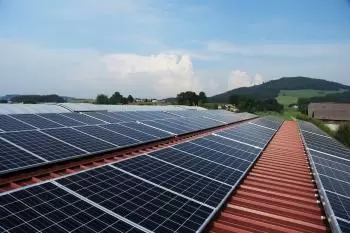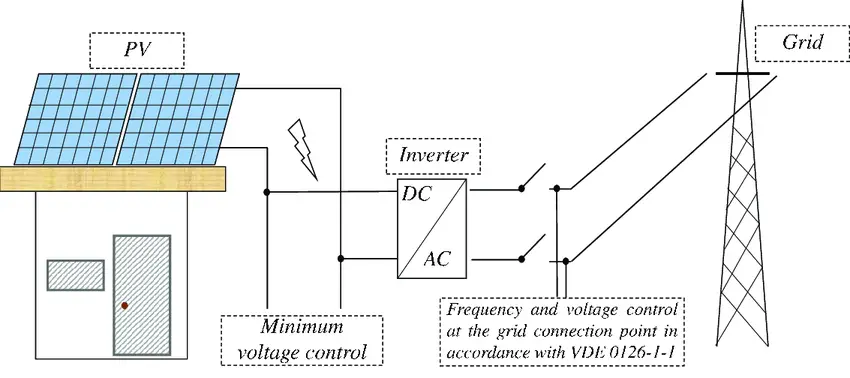
An on-grid solar system is an electrical generator using solar energy, a non-conventional source of energy. In contrast with off-grid systems, grid-tied systems are connected to the grid. As a consequence, the not used generated power of the system can be sold to the electrical company. In addition, the user can buy energy from the grid if needed.
In the basic scheme of an on-grid PV solar system, it must have the following parts:
-
An array of solar panels to transform solar radiation into electrical energy.
-
A solar inverter that transforms the DC power generated by the solar array panels into AC power.
-
A connection box with the commercial electrical grid.
-
A net meter, in order to take control of the amount of energy supplied to the grid.
In the following diagram, we show the scheme of a grid-tied PV solar system:

The main difference between a solar installation connected to the grid and a self-consumption installation is that the user supplies the surplus power generated to the grid at an agreed price. On the other hand, if you need more electrical power than the plates supply at any time, you can buy the electricity from the electric company.
The main advantage of grid-connected PV systems is that the user saves the cost-effectiveness of batteries and does not need a support system to generate electricity.
Combining both models by using a battery backup is also possible. In the case of an isolated installation, solar batteries are mandatory.
Below we detail the characteristics and functions that each of the main components of a grid-connected solar PV system must have:
Solar panels: function, types, and characteristics
PV solar panels are essential in grid-tied systems and off-grid systems. Their mission is to transform sunlight into electrical energy.
Solar panels are usually located on the building’s roof or integrated into any structural element of the same building. Photovoltaic panels can also be placed directly on any land near the electricity grid.
The efficiency of a PV panel is mainly subject to the quality of the silicon it contains. The purer the silicon, the better it converts solar energy into electrical energy.
Types of solar panels
There are three types of solar panels:
-
Monocrystalline silicon solar panels are the ones whose silicon is the purest and, therefore, the most efficient.
-
Polycrystalline silicon PV solar panels are less pure and expensive than the last option.
-
Thin-film PV panels are the most used and cheapest solar panel for home systems.
How do they generate electricity?
Solar cells convert solar radiation into electricity through the photovoltaic effect. These solar cells are generally black or dark blue, are associated in arrays, and are protected from the environment, creating electrical devices called PV solar panels.
Several solar panels, together with the electrical wires that join them and with the support and fixing elements, constitute what is known as a solar generator.
The PV generator is responsible for transforming solar radiation into electrical energy. This electricity is produced in direct current, and its characteristics depend on the energy intensity of solar radiation and the ambient temperature.
Solar inverter: what function does it have?
A grid-tied solar energy system works by generating DC power from the solar panels. Then, a power inverter converts the DC power into AC power with the same characteristics as that of the electrical utility grid.
There are different types of inverters, but it is advisable to choose them based on the size of the installation to be carried out.
Properties of solar inverters
In any grid-tied solar power project, the inverter is the system's heart. It is vital to be clear about the technical characteristics:
-
Inverter power
-
Working ranges
-
DC-AC voltage
-
Frequency
-
Maximum power reached
The power accumulated by the number of inverters will determine the nominal capacity of the solar power plant in any PV system connected to the grid.
For each on-grid system, we can find a whole range of equipment (expressed in its nominal power) for its use.
In grid-tied solar systems where more than 100 kW are already installed, the equipment can have nominal powers of 10 kilowatts and above. The equipment that has in its technical characteristics the maximum of the protections established by the current regulations is chosen to increase the system's security and reduce installation costs in general.
Net meter
The photovoltaic generator needs two net meters between the inverter and the grid to control the energy consumed and supplied to the electrical grid.
One is used to quantify the energy generated and injected into the grid for billing. Another is used to quantify the small consumption (< 2 kWh/year) of the photovoltaic inverter in the absence of solar radiation. The second meter also guarantees the electricity company of possible consumption that the owner of the installation could make.
The building's electricity consumption will be made from the grid, with its net meter independent of the PV system.